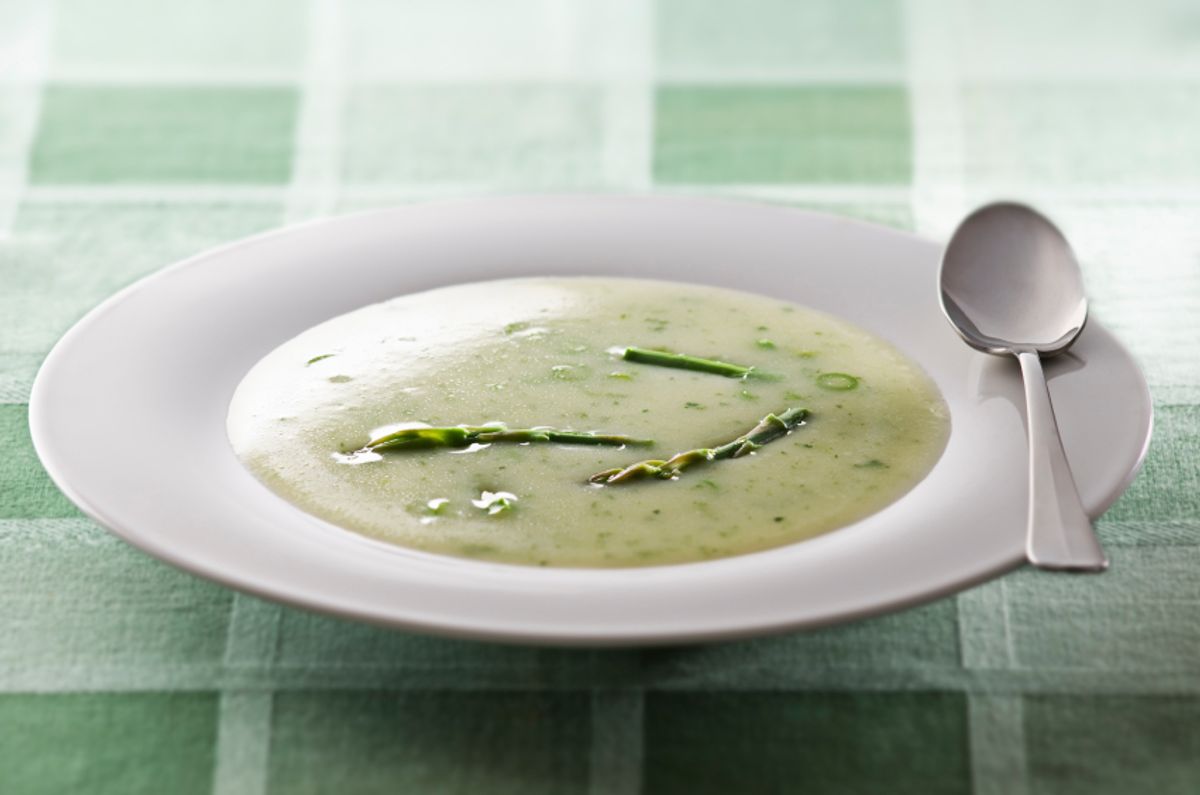I know it's embarrassingly old fashioned, but I've always loved "cream of" soups. And while we're being honest, it's never even really mattered too much to me what came after the "cream of," because I'm really just in it for that floating, haunting richness, that deep savoriness, that smooth, velvety feeling on my tongue. If I end up getting some broccoli or asparagus or whatever in my system while I'm at it, well hey -- winning!
But cream-ofs rarely get people excited anymore. Maybe it's because they seem a little too Miss Daisy? Or because it's hard to come back into the fold once you've opened a red-labeled can of the stuff and watched it fall, in gloopy chunks, into your casserole dish? Or maybe because every cafeteria has a tub of some poor, misbegotten cream-of sitting somewhere, hot and gluey, tasting like milk and flour and sadness?
Well, imagine for a minute a better place, a happy place, where cream-ofs are lively and vibrant, where they have real flavor and a texture that's smooth and satisfying, not leaden and semisolid. That happy place is in your pot, and it's easier than you might realize. You don't really even need a recipe.
The key is knowing the procedure: You sweat some aromatics and the main ingredient (the part that comes after "of") in a little butter or oil, sprinkle on just enough flour to pull it together, add some stock, simmer, puree it and finish with a shot of cream. The sweating brings out flavor, the flour mixes with the fat to form a quick, thickening roux, the simmering marries all the ingredients, pureeing smoothes and thickens, and the cream, well, the cream is the power move, of course.
Fundamental cream-of-anything soup
Adapted from "The Professional Chef," 7th edition, Culinary Institute of America
Serves 4-6 as an appetizer (about 1 quart of soup)
Ingredients
- 1 pound broccoli (or whatever -- asparagus, mushrooms, celery, lettuce, cauliflower, chicken, carrot, peas, you get the picture), roughly chopped
- ½ cup chopped onion (about 2 ounces, or ½ of a small onion)
- 1 stalk celery, chopped
- Aromatics of your choice -- garlic, shallots, ginger, scallions, chilies etc.
- 3 tablespoons butter or vegetable oil
- 3 - 4 tablespoons flour
- 2 cups (plus more as needed) chicken, vegetable, or other kind of stock
- ¼ - ½ cup heavy cream
- Salt and pepper to taste
Directions
- In a heavy pot over medium heat, sweat the broccoli (or whatever you're using), the onions, celery and aromatics in the butter or oil. Stir frequently and don't let it brown -- turn down the heat if you have to -- but cook them until the onions are translucent and soft, and the other vegetables are softening. Season with a little bit of salt and pepper.
- Sprinkle on three tablespoons of flour and stir thoroughly. You want the flour to start to pull all the vegetables together and turn them dull-looking, absorbing all their sheen. If they're still kind of shiny with fat, sprinkle on the remaining flour -- go by eye, and just use enough to make it look like there's a matte coat on everything. Cook, stirring, until the flour starts to turn a light blond color, about 10 minutes. Congratulations, you just made a roux and sweated your vegetables at the same time. See? Told you this was easy.
- Slowly add the stock to the pot, stirring or whisking to make sure no lumps form in the roux. Once all the stock is in, bring it up to a boil over high heat, then turn down to a gentle simmer. Simmer at least 20 minutes, stirring every few minutes, until the vegetables are all quite soft and the soup appears thickened. (You want to simmer it at least 20 minutes to cook all the raw taste of the flour out.) If foam or scum floats to the top, just skim it off.
- When all the vegetables are soft, puree the soup in a blender, with an immersion blender, or if you're old-school, in a food mill. (If you're using a green vegetable as your main flavor ingredient and want some more color, feel free to add in some fresh parsley leaves to the simmering soup three minutes before pureeing -- its color will brighten it back up a bit.)
- Put the soup back in the pot, add cream to taste and bring back up to a simmer. If it's too thick, thin it with a little stock; too thin, add a little more cream or let it gently simmer to reduce. Taste, adjust seasoning with salt and pepper, garnish and serve.
How to garnish your soup: "Garnish" is the term of art, but I admit it sounds a little silly and froufrou. And, of course, garniture can be extraneous, but there's a lot to be said for the added element of surprise, flavor, texture or visual appeal of a nicely garnished soup. So when deciding whether and how to garnish a soup, think of complementary or contrasting textures and flavors. Maybe a few crisp croutons or toasted nuts. Maybe an extra dollop of sour cream, or flavored whipped cream. Maybe a few bits of fried ham, chopped herbs or something as simple as bite-size pieces of the main ingredient, like extra broccoli florets quickly boiled tender-crisp and floating on top.



Shares